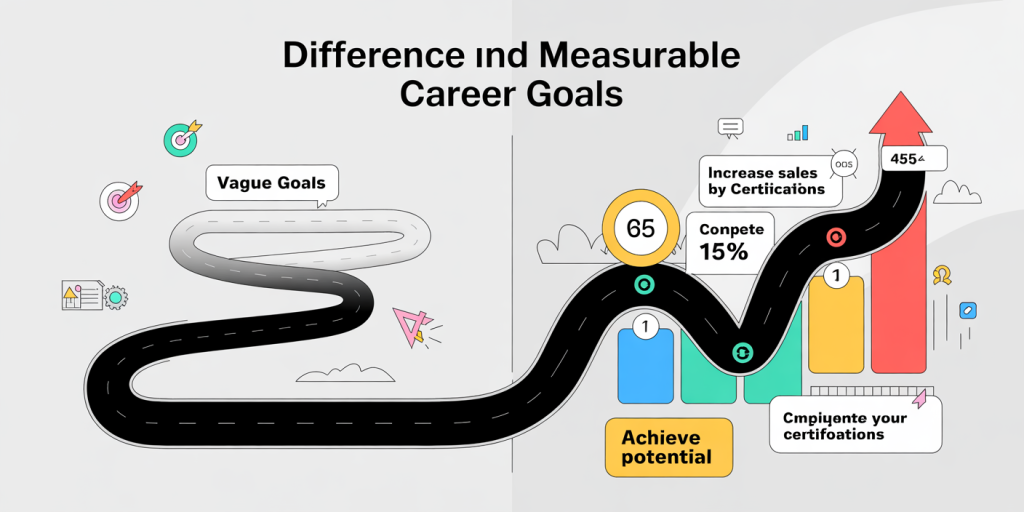How to Create SMART Goals to Accelerate Your Career
In today’s fast-paced, competitive work environment, setting clear and purposeful career goals has become more crucial than ever. Goals give direction, motivate consistent progress, and enable professionals to measure success effectively. However, many individuals struggle with vague ambitions, leading to stagnation or frustration. To overcome this challenge, adopting the SMART goal framework has proven to be an invaluable strategy. This article explores how to create SMART goals tailored to accelerate your career growth, supported by practical examples, statistical insights, and comparative analysis.

The Importance of Clear Goal-Setting in Career Advancement
Goals act as roadmaps, guiding professionals toward meaningful achievements while providing a sense of purpose. According to a study by Dr. Gail Matthews from Dominican University, people who write down their goals are 42% more likely to achieve them compared to those who simply formulate goals mentally. This illustrates the power of clarity and commitment in career development.
Without well-defined objectives, career progression often becomes haphazard and inefficient. A report by Gallup in 2022 showed that only 40% of employees strongly agreed they know what is expected of them at work, which contributes to disengagement and low productivity. Setting SMART goals can address this issue by aligning personal aspirations with professional expectations, enhancing focus and accountability.
Understanding the SMART Goal Framework
The SMART acronym stands for Specific, Measurable, Achievable, Relevant, and Time-bound. Each component ensures that goals are clear and attainable, preventing common pitfalls associated with vague or unrealistic targets. Specific goals clearly define the desired outcome rather than stating a broad intention. Measurable goals include concrete criteria to track progress and success. Achievable goals must be realistic, considering available resources and constraints. Relevant goals align with broader career objectives and values. Time-bound goals specify deadlines to instill urgency and prioritization.


For example, instead of setting a goal like “improve my skills,” a SMART goal would be “complete an advanced Excel certification course within the next three months to increase data analysis capabilities for my marketing role.”
Crafting Specific Goals: The First Step to Clarity
Specificity lays the foundation for goal success by answering the “What?” “Why?” and “How?” questions. For a career goal to be specific, it should clearly articulate the results desired and the actions required to get there.
Consider the difference between “I want to get promoted” and “I want to secure a senior analyst position in my company by enhancing my Excel, SQL, and presentation skills through targeted training and project involvement.” The latter is detailed with clarity about the position, skills, and methods, making it easier to create an actionable plan.
Practical example: Sarah, a mid-level marketing associate, wants to increase her visibility within her department. By making her goal specific— “Lead three cross-functional marketing campaigns this year to develop leadership experience” —she transforms an abstract desire into a tangible roadmap. This clarity motivates consistent progress and facilitates tracking.
Emphasizing Measurability: Tracking Your Progress
Measurable goals enable professionals to track milestones and quantify achievements, essential for maintaining motivation and making adjustments. Key performance indicators (KPIs), numerical targets, or tangible outputs transform subjective ambitions into objective data.
For instance, “Increase my monthly sales revenue” is improved by making it measurable: “Increase monthly sales revenue by 15% over the next six months through upselling and customer engagement initiatives.” Tracking this percentage helps individuals monitor results, identify successful tactics, and recalibrate strategies if progress stalls.
A comparative table highlights differences between vague and measurable goals in career contexts:
| Aspect | Vague Goal | Measurable Goal |
|---|---|---|
| Description | Improve customer service skills | Achieve a customer satisfaction rating of 90% by Q4 2024 |
| Progress Tracking | Subjective feeling of improvement | Monthly customer feedback surveys and performance reviews |
| Motivation | Uncertain | Clear progress indicators encourage sustained effort |
| Outcome Evaluation | Difficult to assess | Objective benchmarks determine success |
This table reinforces that measurability is a critical factor in sustaining progress and validating efforts.
Setting Achievable Goals: Balancing Ambition with Reality
Ambition drives career growth, yet setting excessively unrealistic goals can result in burnout or disappointment. Achievability ensures that goals stretch one’s capacities without becoming unattainable. This balance improves self-confidence and fosters a growth mindset.
Research from the Harvard Business Review suggests that individuals who set overly ambitious goals experience decreased motivation when faced with setbacks, while moderate, challenging goals enhance persistence. Therefore, assessing one’s current skills, resources, and time constraints before committing to goals is critical.
For example, a software developer aiming to transition into a managerial role should first evaluate if they have leadership experience or mentorship opportunities. A more achievable goal might be, “Complete a project management certification and lead a small team project within the next 12 months,” rather than aiming for an immediate managerial promotion.
Ensuring Relevance: Aligning Goals with Career Aspirations
Goal relevance ensures that your objectives support long-term career vision and personal values, preventing misdirected effort on non-beneficial tasks. Irrelevant goals may consume time but do little for career progression, potentially causing frustration.
Suppose an employee in customer service sets a goal to learn graphic design. While it promotes skill diversification, it may not contribute to immediate career advancement unless tied to a role involving marketing or communication.
Real-life case: John, an IT technician, aspired to transition toward cybersecurity. His relevant goal was to obtain the CompTIA Security+ certification within 6 months, a credential directly aligned with his career change. This focused pathway accelerated his job transition by providing targeted skills and marketable qualifications.
Time-Bound Goals: Creating a Sense of Urgency and Focus
Deadlines help maintain momentum and reduce procrastination. Time-bound goals specify when accomplishments are expected, helping to prioritize efforts and prevent distractions.
A 2021 study by the American Psychological Association found that individuals with deadlines are 70% more likely to complete goals promptly. This illustrates the impact of time constraints on productivity.
Consider the difference between “Improve public speaking skills” and “Deliver three presentations at team meetings within the next quarter to improve public speaking skills.” The latter provides clear checkpoints to track efforts and celebrate progress.
Practical Steps to Implement SMART Goals in Your Career
To adopt the SMART framework effectively, start with self-assessment. Identify your strengths, weaknesses, and opportunities for growth to select meaningful goals. Then, draft goals that satisfy all SMART criteria, using tools such as goal-setting worksheets or digital apps to stay organized.
Example process: 1. Specific: Define your target — e.g., “Increase client acquisition.” 2. Measurable: Set metrics — e.g., “Add 10 new clients monthly.” 3. Achievable: Assess resources — e.g., “Use current network and marketing budget.” 4. Relevant: Align with your role — e.g., “Supports sales targets.” 5. Time-bound: Set deadline — e.g., “Achieve within 6 months.”
Regularly review and adjust goals as circumstances evolve. Collaborate with mentors or supervisors for feedback and accountability. Document progress through journals or digital trackers to maintain clarity.
Future Perspectives: Evolving Your Career with Adaptive SMART Goals
As industries and technologies innovate rapidly, static goals risk becoming obsolete. Adapting SMART goals to reflect changes in market conditions, personal interests, and skills is essential for sustained career acceleration.
The future of work emphasizes lifelong learning, flexibility, and agility. For instance, remote work trends demand new competency goals, such as mastering virtual collaboration tools or digital communication etiquette.
Emerging generations prioritize purpose-driven careers, requiring goals that also incorporate personal values and social impact. Integrating Environmental, Social, and Governance (ESG) factors into relevant criteria may become standard practice.
Moreover, artificial intelligence and data analytics offer powerful tools for refining goal-setting strategies by providing real-time feedback on performance metrics and predictive insights.
By embracing adaptive SMART goals, professionals can maintain relevance, seize new opportunities, and drive continuous career growth in an ever-changing landscape.
—
In summary, creating SMART goals is a proactive method to accelerate career advancement. By ensuring goals are specific, measurable, achievable, relevant, and time-bound, professionals can enhance focus, motivation, and effectiveness. With strategic planning and periodic reassessment, SMART goals become dynamic tools empowering sustained success in today’s competitive job market.
